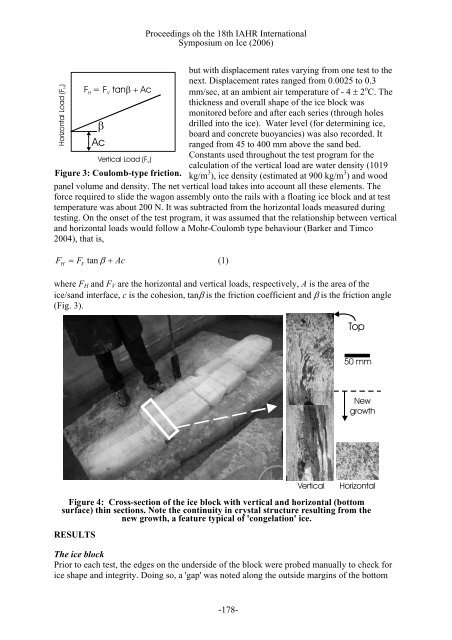Proceedings oh the 18th IAHR Internati<strong>on</strong>alSymposium <strong>on</strong> Ice (2006)Horiz<strong>on</strong>tal Load (F )HF=HFVtanβ + AcβAcVertical Load (F )VFigure 3: Coulomb-type fricti<strong>on</strong>.but with displacement rates varying from <strong>on</strong>e test to thenext. Displacement rates ranged from 0.0025 to 0.3mm/sec, at an ambient air temperature of - 4 ± 2 o C. Thethickness and overall shape of the <str<strong>on</strong>g>ice</str<strong>on</strong>g> block wasm<strong>on</strong>itored before and after each series (through holesdrilled into the <str<strong>on</strong>g>ice</str<strong>on</strong>g>). Water level (for determining <str<strong>on</strong>g>ice</str<strong>on</strong>g>,board and c<strong>on</strong>crete buoyancies) was also recorded. Itranged from 45 to 400 mm above the <strong>sand</strong> bed.C<strong>on</strong>stants used throughout the test program for thecalculati<strong>on</strong> of the vertical load are water density (1019kg/m 3 ), <str<strong>on</strong>g>ice</str<strong>on</strong>g> density (estimated at 900 kg/m 3 ) and woodpanel volume and density. The net vertical load takes into account all these elements. Theforce required to slide the wag<strong>on</strong> assembly <strong>on</strong>to the rails with a floating <str<strong>on</strong>g>ice</str<strong>on</strong>g> block and at testtemperature was about 200 N. It was subtracted from the horiz<strong>on</strong>tal loads measured duringtesting. On the <strong>on</strong>set of the test program, it was assumed that the relati<strong>on</strong>ship between verticaland horiz<strong>on</strong>tal loads would follow a Mohr-Coulomb type behaviour (Barker and Timco2004), that is,F= F tan β Ac(1)H V+where F H and F V are the horiz<strong>on</strong>tal and vertical loads, respectively, A is the area of the<str<strong>on</strong>g>ice</str<strong>on</strong>g>/<strong>sand</strong> interface, c is the cohesi<strong>on</strong>, tanβ is the fricti<strong>on</strong> coefficient and β is the fricti<strong>on</strong> angle(Fig. 3).Top50 mmNewgrowthVerticalHoriz<strong>on</strong>talFigure 4: Cross-secti<strong>on</strong> of the <str<strong>on</strong>g>ice</str<strong>on</strong>g> block with vertical and horiz<strong>on</strong>tal (bottomsurface) thin secti<strong>on</strong>s. Note the c<strong>on</strong>tinuity in crystal structure resulting from thenew growth, a feature typical of 'c<strong>on</strong>gelati<strong>on</strong>' <str<strong>on</strong>g>ice</str<strong>on</strong>g>.RESULTSThe <str<strong>on</strong>g>ice</str<strong>on</strong>g> blockPrior to each test, the edges <strong>on</strong> the underside of the block were probed manually to check for<str<strong>on</strong>g>ice</str<strong>on</strong>g> shape and integrity. Doing so, a 'gap' was noted al<strong>on</strong>g the outside margins of the bottom-178-
Proceedings oh the 18th IAHR Internati<strong>on</strong>alSymposium <strong>on</strong> Ice (2006)kN30201000 100 200 300 400 500Time (sec<strong>on</strong>ds)IncreasingverticalloadFigure 5: Horiz<strong>on</strong>tal load traces from <strong>on</strong>e test series,for vertical loads ranging from 9 to 63 kN.surface, such that <strong>on</strong>ly about70% of that surface was in actualc<strong>on</strong>tact with the sediments.(Since both the normal and thetangential loads are normalizedover surface area, this reducti<strong>on</strong>in effective footprint does notaffect the results of our study.)When the <str<strong>on</strong>g>ice</str<strong>on</strong>g> was unloaded andallowed to float during the testprogram, visibility was too poor(due to the fine sediments insuspensi<strong>on</strong>) to allow a glance atthe bottom surface with anunderwater camera. However, upto three refrozen <str<strong>on</strong>g>ice</str<strong>on</strong>g> cracks a fewmillimetres in thickness running across the top surface of the block were observed later afterunloading the <str<strong>on</strong>g>ice</str<strong>on</strong>g>. It is uncertain how this may have affected the <str<strong>on</strong>g>ice</str<strong>on</strong>g>-<strong>sand</strong> interacti<strong>on</strong>.)Horiz<strong>on</strong>tal load (kN302010F H = 0.47F V + 1.6F H = 0.39F V + 0.3600 20 40 60 80Vertical load (kN)STATICKINETICLinear (STATIC)Linear (KINETIC)Figure 6: Linear behaviour of thehoriz<strong>on</strong>tal/vertical load ratio. The y-intercept (up<strong>on</strong>extrapolating) represents cohesi<strong>on</strong>.the <str<strong>on</strong>g>ice</str<strong>on</strong>g> salinity was about 5 ‰ at the beginning of testing, bureflecting the temperature fluctuati<strong>on</strong>s the <str<strong>on</strong>g>ice</str<strong>on</strong>g> had underg<strong>on</strong>eAt the end of the program, the waterwas removed from the test basin andthe <str<strong>on</strong>g>ice</str<strong>on</strong>g> was secti<strong>on</strong>ed with a chain saw(Fig. 4). At that tim e, it had a totalthickness of 345 mm in the centre,thinning down to 260 mm al<strong>on</strong>g themarg ins, with a width of 1.96 m al<strong>on</strong>gall edges. The sec<strong>on</strong>d (new) <str<strong>on</strong>g>ice</str<strong>on</strong>g>growth phase led to a c<strong>on</strong>spicuoushoriz<strong>on</strong>tal layering, shown in Fig. 4.The upper porti<strong>on</strong> of the <str<strong>on</strong>g>ice</str<strong>on</strong>g> sheet wasdominated with mm-sized crystalsresembling frazil <str<strong>on</strong>g>ice</str<strong>on</strong>g>, which extendeddown ward in a columnar structure. Nosediments were incorporated into the<str<strong>on</strong>g>ice</str<strong>on</strong>g>, with the excepti<strong>on</strong> of thelowermost 30 to 40 mm, where the <str<strong>on</strong>g>ice</str<strong>on</strong>g>was slightly brownish. Interestingly,t averaged 2 ‰ at the end,throughout the test program.Fricti<strong>on</strong> coefficientsExamples of load traces (the cumulative resp<strong>on</strong>se of both load cells) are shown in Fig. 5 for aseries of <strong>tests</strong> with increasing vertical load. These, and those for all other <strong>tests</strong>, display asimilar pattern of strain softening: a regular increase in horiz<strong>on</strong>tal load with time (ordisplacement) up to a peak, followed by a sudden drop and levelling off of the load. The peakload is that required to overcome static fricti<strong>on</strong>; the flat porti<strong>on</strong> of the load trace is the resultof the kinetic fricti<strong>on</strong>. When the latter segment was not perfectly flat, an average value wasrecorded. In some instances, the load trace at that stage comprised random (as shown by someof the traces in Fig. 5) or systematic cycling, thought to result from, respectively, slip-179-
















